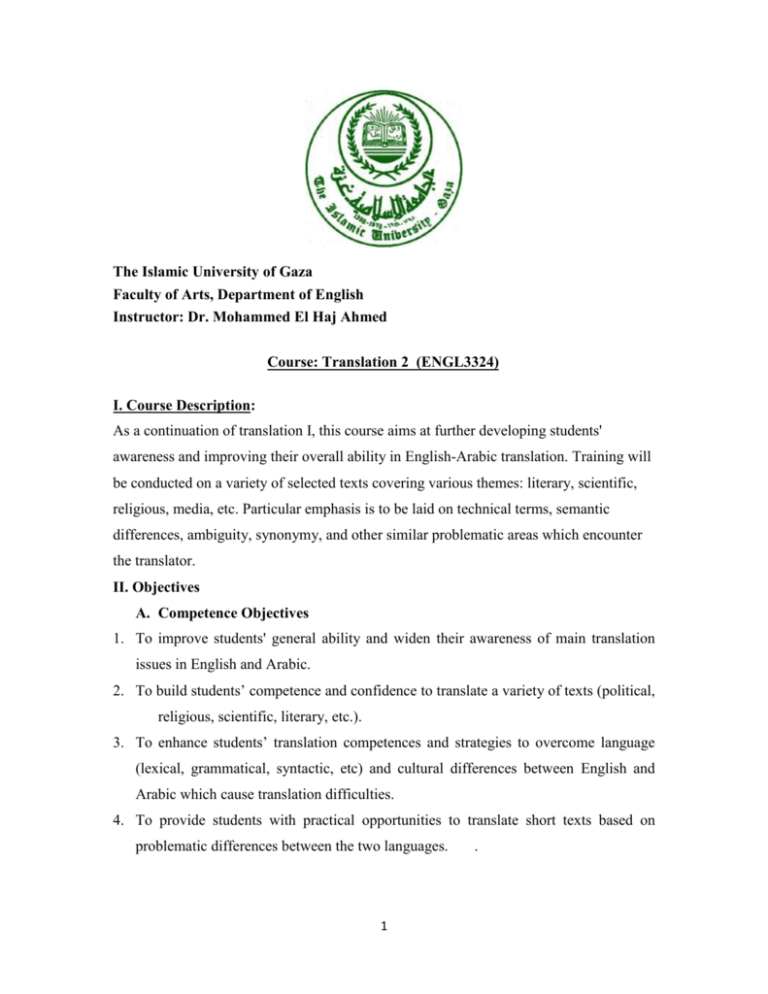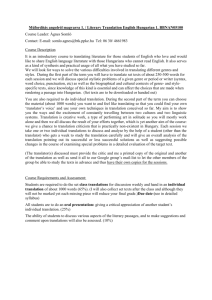El Haj Ahmed, M. (2009) Lexical, Cultural and Grammatical
advertisement

The Islamic University of Gaza Faculty of Arts, Department of English Instructor: Dr. Mohammed El Haj Ahmed Course: Translation 2 (ENGL3324) I. Course Description: As a continuation of translation I, this course aims at further developing students' awareness and improving their overall ability in English-Arabic translation. Training will be conducted on a variety of selected texts covering various themes: literary, scientific, religious, media, etc. Particular emphasis is to be laid on technical terms, semantic differences, ambiguity, synonymy, and other similar problematic areas which encounter the translator. II. Objectives A. Competence Objectives 1. To improve students' general ability and widen their awareness of main translation issues in English and Arabic. 2. To build students’ competence and confidence to translate a variety of texts (political, religious, scientific, literary, etc.). 3. To enhance students’ translation competences and strategies to overcome language (lexical, grammatical, syntactic, etc) and cultural differences between English and Arabic which cause translation difficulties. 4. To provide students with practical opportunities to translate short texts based on problematic differences between the two languages. 1 . 5. To provide students with practical opportunities to translate short texts containing cultural or non-equivalent phrases. 6. To widen students' vocabulary repertoire and word construction. B: Skills Objectives: 1. demonstrate knowledge and understanding of main translation issues in English and Arabic. 2. demonstrate knowledge and understanding of the common translation problems related to the multi-level linguistic differences between Arabic and English. 3. translate short texts that are problematic and based on linguistic and cultural differences between Arabic and English. 4.identify and overcome lexical, grammatical, cultural and discourse problems, using appropriate translation strategies and techniques. 5. use the vocabulary and expressions discussed in a variety of meaningful contexts. 6. to develop students' simultaneous and consecutive interpreting skills. 7. to develop students' public speaking skills through presentations and simulation. 8. to develop the two linguistic notions of monitoring and managing through students' engagement in analyzing different text types. C. Value Objectives 1. To help the student translator disseminate the Islamic values in general and the values and principles of the IUG in particular 2. To employ the bicultural role of the translator in bridging the differences between the eastern and western cultures 3. To help students better convey the daily sufferings and hardship practised against them and their people by the Israeli occupation 2 III. Course Components: Topic Introduction and revision of topics studied in the previous course No. of Lectures One week Connotative meaning and translation issues: Two weeks Practical 1: collocation Practical 2: Connotative meaning الرحلة Grammatical Issues in translation: grammatical arrangement, morphological repetition, lexical repetition Two weeks Practical 3: حوار الثقافات Sentential issues in translation: theme&rheme, foregrounding and backgrounding, translation of Arabic coordinated clauses Two weeks Practical 4: لقد دفعت السعودية Discourse and intertextual issues in Translation: Three weeks The discourse level: cohesion and coherence, sentence splitting, textual restructuring, paragraphing The intertextual level: genre membership, quotation and allusion Practical 5: األخوان المسلمون Practical 6: أكراد العراق Mid-term exam & exam feedback One week Practicals : translation of other types of texts : legal, literary, political etc. Final Exam Four weeks One week 3 IV. Assessment: The course assessment is based on the following: 1. Mid-term exam 30 2. Attendance, participation and assignments 20 % 3. Final Exam 50% V. Methods of Teaching 1. 2. 3. 4. 5. Lectures Group work Role playing Discussion Practice VI. Text book: Dickins et al (2002). Thinking Arabic Translation: A Course in Translation Method: Arabic to English. London and New York: Routledge. Handouts of texts covering topics in the news VII. Further readings: Baker, M. (1992). In Other Words: A Coursebook on Translation. London and New York: Routledge El Haj Ahmed, M. (2009) Lexical, Cultural and Grammatical Translation Problems Encountered by Palestinian Learners at the Islamic University of Gaza, Palestine. PhD Thesis, University of Salford. Farghal, M. and Shunnag, A (1999). Translation with Reference to English and Arabic: A Practical Guide. Jordan: Dar Al Hilal for Translation. 4







